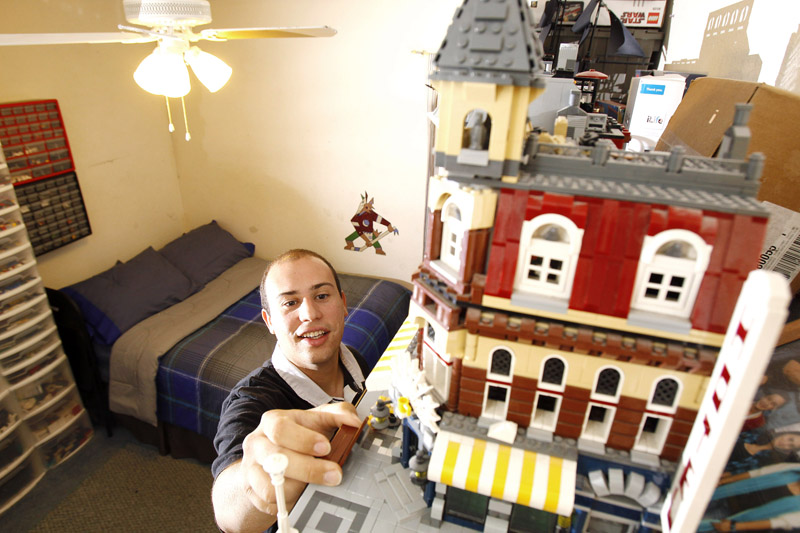Around age 14, Christopher Piccirillo sank into what he calls the “dark ages,” a period in a young person’s life – usually adolescence – when he or she shuns one of the greater joys of childhood: playing with Lego.
Some five years later, he emerged, with an appetite for the colorful plastic bricks more voracious than that of many kids.
“The possibilities are endless,” says Piccirillo, now 26 and running a business in Phoenix that organizes after-school Lego clubs. “You can go anywhere you want with it.”
As an adult lover of Lego, Piccirillo is part of a growing community known as Adult Fans of Lego – AFOL, for short. Executives at The Lego Group estimate the AFOL world to be 40,000 strong worldwide and growing, as children who grew up using the construction toy become parents themselves.
Adult fans – who hold conventions, organize group meetings, and buy and trade bricks online – account for roughly 5 percent of Lego sales, says Michael McNally, Lego’s North American director of brand relations. They represent the first and second generations of Lego users; although the Danish company dates back to 1932, the plastic Lego brick did not debut in the United States until the mid-’60s.
But from Lego’s perspective, adult fans are much more than another way to make money, McNally says. They regularly take Lego creations to a new level.
Although Lego bricks are typically sold in sets with instruction manuals, adult fans branch out to build everything from giant model cities and life-size TV characters to abstract art. “We find that a lot of the people have niche focuses, so there are train people and castle people and space people,” says Julie Stern, a Lego brand manager for North America.
Showing creations online is particularly popular. Lego videos – including stop-action shorts using Lego characters – make up 2 percent of all videos on YouTube, or more than 2 million videos, with the vast majority created by fans, Stern says.
AFOLs also have created forums such as Mocpages.com for showcasing their models.
One adult fan, Jamie Berard, made such a big impression on Lego’s owner, Kjeld Kirk Kristiansen, that he was hired as a product designer. Kristiansen – the third-generation owner of the family-owned Lego company – met Berard at BrickFest in Washington, D.C., where Berard showed a functioning Lego Ferris wheel, along with other amusement park models.
“When you see these little pieces in such different ways, it’s really mind blowing – and humbling,” McNally says.
Piccirillo, too, has made Lego more than a hobby; it’s a way of life. He not only established his business – there are 600 kids from three Phoenix-area school districts enrolled in his Lego building programs – but also created a community for fellow enthusiasts. Two years ago, he established an AFOL club, which has more than 50 members, about half of whom attend monthly meetings. Some in the group host events, such as swaps of mini-figures – small Lego people. Others buy, sell and trade Lego pieces online.
According to Stern, mini-figures are generally the most prized possession, with some going on eBay for more than $30 each.
“The fans like to customize the mini-figures. Some have even gone so far as to add LED lights,” says Stern.
“Star Wars” figures in particular are perennial hits, she says.
Jenn Wagner, aka the Brick Chick, has a small business in Waterloo, Ontario, selling Lego parts and pieces that “only serves to make enough money to support my habits in the hobby.”
Wagner, 42, became hooked on Lego about 10 years ago after buying “Star Wars” sets for her children. Now, she says, Lego – business, volunteer projects, clubs and conventions – takes up “80 percent or more of my time.” She is involved in orchestrating Canada’s first-ever Lego fan convention, scheduled for next year in Toronto.
Some say the adult onset of Lego love fulfills childhood career dreams: “If you asked me when I was 12 what I was going to be when I grew up, I was going to be a master model builder,” says Jonathan Bender, a Kansas City, Mo., author, who explores the vast AFOL world in the new “Lego: A Love Story” (John Wiley and Sons, 2010).
Though Bender initially set out to write as an observer, he quickly found himself swept up in the Lego world.
“It just became apparent to me that you cannot be in a room with Lego and not want to play,” he says.
Lego also cast its spell on Angus MacLane, a 35-year-old Pixar animator who just wrapped up working on the upcoming film “Toy Story 3.” MacLane’s job might already seem as cool as they come – but he says that consulting with Lego on “Toy Story” products being issued with the movie was a great perk.
A limited edition Buzz Lightyear “CubeDude” – a MacLane-trademarked Lego figure that he builds and displays online – was distributed as a promotion, to boot.
And despite his artistic day job, MacLane says he still gravitates toward Lego in his spare time as a means of expressing himself.
“I do have a creative job, but there are always creative compromises, and the work is mostly done sitting in front of a computer,” MacLane says. “With Lego, there are only the limitations of what pieces I have in my Lego collection.
“I am my own art director and I only build what I want, when I want to.”
Send questions/comments to the editors.



